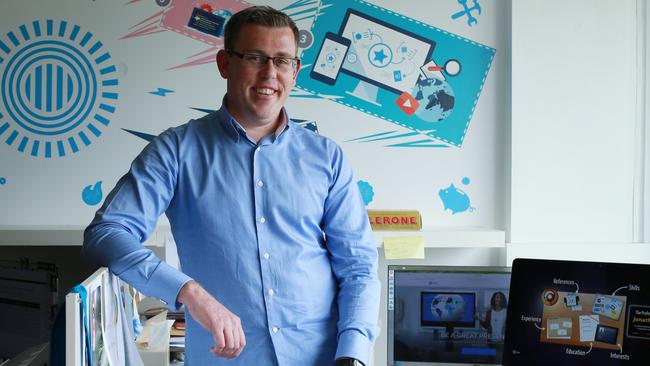Video technology a job-hunt weapon
PROSPECTIVE employers are turning to video technologies to select staff.

JOB applicants need an edge to stand out when looking for a job, as unemployment rises and positions become harder to come by.
That edge, according to technology experts and human resources executives, is increasingly being exploited by savvy 20-somethings who harness software and applications to enhance their strengths and demonstrate they understand the tech world.
As candidates harness IT to promote themselves, Polycom’s Asia-Pacific head of talent acquisition and development Eric Wong says companies are increasingly turning to video technology to interview prospective staff and communicate internally.
“Videoconferencing allows us to improve our human resources processes,” Wong says, speaking from a visit to Hyderabad, India.
Video resumes or presentations can prove a candidate understands technology, but live connections make interviewing more efficient, Wong says, particularly when people vying for jobs may be in other countries.
“A lot of companies we’re finding are using voice interviews but you don’t get the true flavour (of who they are),” he says. “With video you can see the candidate without the cost. It allows us to turn around (the interview process) quickly and see the candidate. You can record an interview and review the session and this is useful. When you’re down to two or three this is helpful.”
Polycom partners more than 415,000 companies worldwide, including each of the Fortune 100, with customers in education, finance, government, healthcare, manufacturing, media, HR and retail. It employs nearly 4000 people worldwide and has offices in Sydney, Melbourne, Canberra, Brisbane and Perth.
Wong says the increasingly widespread use of video interviews is changing the way HR leaders operate. They can interview people face-to-face instead of flying candidates from interstate, and it can be more time efficient.
“It’s becoming an integral part of human resources,” he says.
US-based career publisher Vault Inc has released a survey that shows 89 per cent of employers would watch a video resume if it were submitted to them, and 52 per cent found the primary reason they valued them was the ability to assess a candidate’s professional presentation and demeanour.
Video technology also helps international companies break down communication barriers between staff in different locations, with personal contact better than a poor phone line.
It can help with training and make it more cost-effective than having an expert travel the country to deliver courses or deliver staff inductions.
Polycom senior vicepresident and chief HR officer Laura Owen says videoconferencing was once the domain of management teams, but technological advancements mean it can be used to promote flexible working arrangements. “You can embed it into your workflow,” Owen says. “You can have video on your iPad ... it’s pretty helpful to increasing productivity and profitability.
“As somebody who has worked at a number of companies where video hasn’t been as prevalent, it has been an eye-opener for me to have daily video interviewing as well.”
Owen says candidates who want to open doors should be asking for videoconferencing interviews — and not just Skyping — because it shows a person is adaptable and willing to make personal contact. She says it enhances relationships between staff and connects those who may feel isolated in a work environment if they are not in the same physical location.
Video technology is also being used by companies to allow real-time messaging, medical appointments, training for nurses and healthcare workers and in regional areas to save people from having to travel to cities for appointments or interviews.
Creating a video resume can be as simple as accessing programs online, or watching YouTube clips for tips on how to maximise their impact. They can be uploaded to video sharing and career networking sites, including jobs boards and LinkedIn.
As popular as they may be, they should never completely replace a paper resume, experts say, and hard copies are always worth producing to mail to potential employers as well.
Kris Flegg, director of Prezi Training and Design, is an expert when it comes to creating online resumes.
While Prezi resumes, or “prezumes”, are not completely video-based, they are tech-savvy productions that are easy to digest.
Flegg says an interactive resume gives jobseekers an edge. It also demonstrates that they are willing to work with new technology, understand the digital age and can move with the times.
“Technology has become cheaper and easier to use, ” Flegg says. “Before, if you wanted something to look beautiful you had to have publishing or desktop skills. Developing an online resume is a tool you can put in your toolkit.”
Jobseekers can use prezume templates online to develop their own, and they can include links to published work, employment history and interactive sites. Work experience is visual, detailed and easy to access.
Flegg says recruiters typically spend less than 10 seconds speed reading job applications and standard resumes, and if people want to be noticed they need to try something different.
“If you really want to stand out, you’ve got this ability to be able to cut through,” he says. “It’s hard to do that when it’s 12-point calligraphy on a page.
“Instead you’ve got this document marketing your skills and expertise and it’s different.”
Technology is changing the face of the jobs market and online or electronic resumes are becoming more popular in the US and Europe. Europeans looking for jobs in Australia have used prezumes to win positions, after being unsuccessful when sending emails or hard-copy traditional resumes. They enable people to send more than just a word document.
Flegg asks people who apply for jobs at his business to use prezumes because he says it shows people are prepared to adapt to changing technology.
“It’s a point of difference in a way that’s easier to understand. For us, asking people to put a prezume together is a great filter.”


